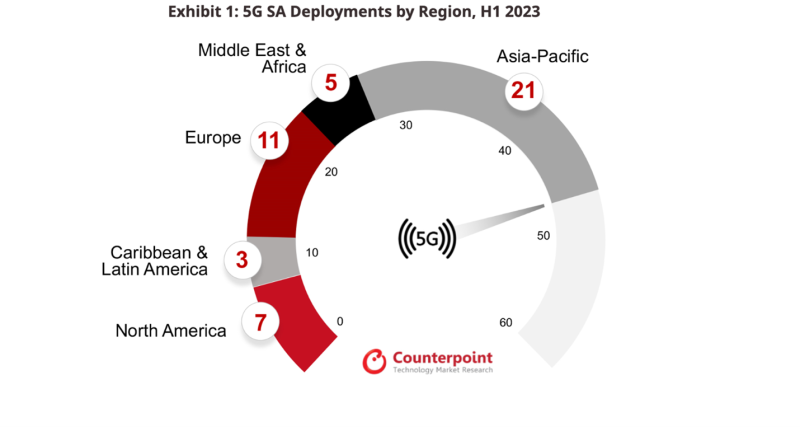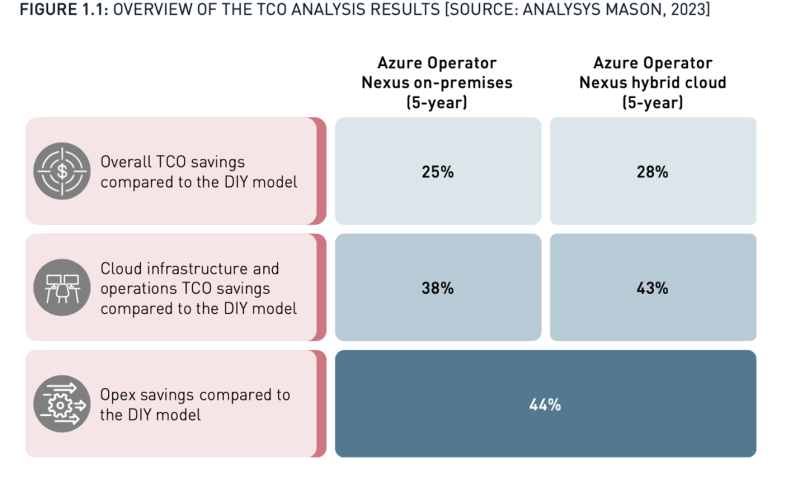Many telcos today are struggling to figure out how to move away from their legacy mobile networks and embrace a 5G standalone (SA) architecture based upon cloud-native fundamentals. This transition is often fraught with complexity and can be challenging for operators that have already invested billions in their existing infrastructures.
Moving to 5G SA is a necessity if telcos want to quickly and cost-effectively deliver new revenue-generating services that demand high speeds, ultra-low-latency and strict QoS guarantees. But it requires telcos to commit to an open, horizontally integrated, distributed, and decoupled deployment model that demands a broad underlying common compute architecture. This modern approach differs wildly from the vertically integrated product and solution stacks of today.
Costs and Clarity Are Causing 5G SA Slowdown
According to Counterpoint Research, as of July 2023 47 operators had deployed 5G SA commercially with many more in the testing and trial phase. The research firm noted that the pace of 5G SA deployments slowed in the first half of 2023, compared to 2022. The main reasons for the slowdown are global macroeconomic conditions coupled with the lack of clear 5G monetization strategies for operators. Nevertheless, the research firm noted that although the pace of 5G SA deployment has slowed, many operators are working on SA-specific use cases such as on-demand network slicing and fixed wireless access (FWA). Meanwhile, open network initiatives driven by the GSMA and the Linux Foundation are working on application programming interfaces (APIs) that will enable the type of modern connected applications that will create new business models in the future.

The Private Cloud Option
Committing to an open, cloud-native, disaggregated and distributed approach to building a mobile infrastructure affords operators greater flexibility when deciding which individual network functions to deploy, and where to deploy them. This means some elements may reside in a public cloud, while others remain on premises at centralized, regional or edge locations. Each of these will have their own set of regulatory, security and operational requirements.
Some telcos opt to build their own private network cloud for their on-premises services. These private clouds typically combine compute and storage with cloud technology and software-defined networking. Analyst firm Analysys Mason refers to these types of private network clouds that are built by the telcos as do it yourself (DIY) deployments because the models stitch together different elements of the cloud but require a complex multi-vendor integration to work. Not only does this increase the cost, but it also limits the functionality of the service.
Analysys Mason, in collaboration with Microsoft, compared the total cost of ownership (TCO) of deploying a modern mobile infrastructure using the DIY private cloud model verses using an on premises and hybrid cloud solution employing Microsoft’s Azure Operator Nexus. Azure Operator Nexus is a carrier-grade, next-generation cloud platform for telecommunication operators that integrates compute, network, and storage, and connects operators to Azure services and resources.
In a five-year TCO model for cloud-native 5G SA deployments, Analysys Mason found that, when deployed on premises, Azure Operator Nexus had an overall TCO that is up to 25% lower than the DIY private cloud model. Furthermore, this model demonstrated a 38% TCO savings on cloud infrastructure and operations as compared to the DIY approach.
The Hybrid Cloud Advantage
Telcos can lower their costs even more if they move to a hybrid cloud architecture. According to the same report, in a five-year TCO model, telcos that use Azure Operator Nexus in a hybrid cloud implementation can see 28% overall lower costs than using the DIY private cloud approach. And the Azure Operator Nexus hybrid cloud architecture offers 43% savings in cloud infrastructure and operations costs over the DIY model.

The hybrid cloud model offers other advantages too because it mixes private cloud and public cloud services, allowing telcos to take advantage of the public cloud while also opting to retain certain applications and data on-site in the on-premise private cloud.
Here are some of the advantages to using the hybrid cloud:
1. Lower costs
One of the big downsides to the DIY private cloud model is that it is expensive to build and must be maintained, which requires ongoing investment. Analysys Mason reports that many operators opting for the DIY route have constructed multiple private clouds, at times dedicating each to a single network function. This strategy has resulted in application silos, reducing the opportunities for cost savings. Plus, these operators must maintain these numerous DIY clouds, resulting in exponential overheads. Common hybrid cloud approaches, such as Microsoft Azure Operator Nexus, are far easier and less expensive to scale so telcos can save money as they grow and add additional services or regions.
2. Security
With hybrid clouds, telcos can take advantage of the security that comes with a private cloud while still enjoying the benefits of public cloud services. Employing the same techniques used to secure Azure, Microsoft assumes the responsibility for securing the Azure Operator Nexus platform, leaving the operator to secure their workloads and data in a manner that meets their unique policies and protocols, along with those mandated by their specific serving regions. Naturally, Microsoft has many services and tools as well as the expertise required to assist with these efforts.
3. Control
With the Azure Operator Nexus hybrid cloud solution, telcos can maintain complete control of their infrastructure, regardless of where it’s deployed. They also enjoy the benefit of granularly governing where workloads are instantiated, and data is stored. This enables dynamic support for time-sensitive processing at the edge or the long-term storage of data in a centralized location, where there are efficiencies of scale or enhanced security procedures in place. This offers significantly greater flexibility than DIY cloud implementations while also avoiding issues surrounding data sovereignty that manifest in alternative multicloud scenarios.
4. Speed
Delivering a common cloud platform for all telco workloads, while also eliminating the need to architect and maintain a DIY cloud, Azure Operator Nexus dramatically reduces the time it takes to deploy new network functions and complete communications services. The hybrid cloud approach also simplifies the expansion of services into new geographic regions, allowing operators to rapidly target entirely new business opportunities. This approach also accelerates new service introduction, allowing telcos to quickly trial and then scale up new offerings.
Moving to 5G SA is becoming increasingly critical for operators who want to stay competitive by offering new services and supporting modern connected applications. However, moving to 5G SA really depends on the operators’ ability to embrace a common cloud-native architecture, regardless of where processing and storage is required. A hybrid cloud is the answer to quickly achieving this goal while reducing risks and keeping costs in check.